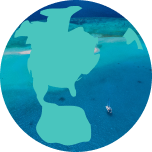
Why Coral Bleaching Matters–And How We Can Help
Coral bleaching is happening throughout the world. Here’s why that matters, and how we can all help.
What are corals?
When many of us think of corals, we often picture giant coral reefs teeming with brightly colored tropical fish. But while that is one type of coral, there are also soft corals, and deep water corals that thrive in cold, deep water.
Corals are known as “colonial organisms,” meaning they’re made up of between hundreds to thousands of polyps, which are individual animals. All corals are an integral part of their habitats, providing critical shelter and food sources to the fish and other marine life that surround them. Out of all the relationships that corals have with other living organisms in their environment, though, the symbiotic relationship that shallow water and reef-building coral has with zooxanthellae–a type of algae that lives in its tissues–is the most crucial. This algae is a critical food source and helps give coral its color.

According to the National Oceanic Atmospheric Association (NOAA), “The coral provides a protected environment and the compounds zooxanthellae need for photosynthesis. In return, the algae produce carbohydrates that the coral uses for food, as well as oxygen. The algae also helps the coral remove waste. Since both partners benefit from association, this type of symbiosis is called mutualism. Deep-sea corals live in much deeper or colder oceanic waters and lack zooxanthellae.” Instead, they “take in plankton and organic matter for much of their energy needs.”
What is coral bleaching?
Coral bleaching refers to the damaging phenomenon where the coral comes under stress, causing the beneficial zooxanthellae algae to leave the coral. In turn, the coral is left without its main food source and loses its color, giving it a “bleached” appearance. When this happens, the coral becomes weak and vulnerable to disease.
Coral bleaching can happen for a number of reasons including, according to NOAA, natural diseases, unsustainable fishing practices, sedimentation, and climate change. Unfortunately, sunscreen can also lead to coral bleaching because certain chemical ingredients–like oxybenzone– are converted into phototoxins. The molecules then become harmful when exposed to sunlight. Warming waters from climate change make the coral more susceptible to sunscreen accumulation and its damaging effects.

Click here to visit another map of reefs that are at risk around the world:
And to learn more about 5 coral reefs that are currently under threat:
Why does coral bleaching matter to the oceans?
Coral bleaching matters to the ocean because coral reefs are some of the most diverse ecosystems on the planet. According to NOAA, “Coral reefs support more species per unit area than any other marine environment, including about 4,000 species of fish, 800 species of hard corals and hundreds of other species. Scientists estimate that there may be millions of undiscovered species of organisms living in and around reefs.” This makes coral reefs invaluable to marine life, and the health of the oceans at large.
Does coral bleaching matter to humans?
Coral bleaching doesn’t matter solely to marine life. Human life is supported by coral reefs in myriad valuable ways. The biodiversity of coral reefs, notes NOAA, is “considered key to finding new medicines for the 21st century. Many drugs are now being developed from coral reef animals and plants as possible cures for cancer, arthritis, human bacterial infections, viruses, and other diseases.”
In addition, healthy coral reefs have a massive impact on our economic and environmental stability. Healthy coral reefs are crucial to supporting the fishing, tourism, and recreation industries. The National Marine Fisheries Services estimates that coral reefs are responsible for the $100 million commercial value of U.S. fisheries. Visitors to coral reefs generate billions of dollars to local economies. And coral reefs also help protect shorelines from damaging storms by providing a natural barrier to waves, storm surge, and flooding, absorbing up to 97 percent of the energy generated by these events. With climate change helping to generate more damaging storms more frequently, healthy coral reefs are more important to humans than ever.
Lastly, Business Insider cites that “up to 85% of the oxygen we breathe comes from the ocean, but a healthy ocean depends on healthy reefs.” Without healthy reefs, we will not be able to live on a healthy planet.

What can we do to help at-risk coral reefs?
According to the U.S. Environmental Protection Agency (EPA), there are daily actions we can take to help at-risk coral reefs. Here are some considerations when it comes to protecting coral reef.
- Avoid interacting with coral reefs
Earth has gifted us astounding beauty. And while we understand that visiting such beautiful locations and supporting local economies that rely on tourism is a meaningful part of living on our shared planet, being a steward for the reefs can help protect them in the long run.
The first step in limiting interaction with coral reefs is to find out if coral reef is present or not where you are. In looking at the map below, you might be surprised to find out that coral reefs are not just present in so-called exotic destinations. Below is a map of areas with coral reef throughout the world.
If you do travel to an area with coral reef, consider avoiding swimming near them or touching the reef when you’re in the water. Interacting from a safe distance will still allow you to enjoy the beauty of coral reefs while helping to protect their fragile ecosystems.
-
Layer on protective clothing
When it comes to the health of coral reefs, protection is the name of the game. Layering on protective clothing like rash guards and other UV-protective swimwear helps cut back on constantly reapplying sunscreen that may damage reefs, while still safeguarding your skin against the sun’s harmful rays.
- Use mineral sunscreen
Even when you do wear UV-protective clothing, dermatologists, pediatricians and scientists agree that wearing SPF on any exposed skin is crucial to keeping your skin safe from harmful UV rays. When you reach for sunscreen, choosing a mineral formula is often considered to be the better option. While research can’t support with 100% certainty that mineral sunscreens have no impact on coral reefs, it is widely accepted by experts that they are much less likely to cause damage compared to chemical sunscreens that contain ingredients like oxybenzone, octinoxate, octocrylene or avobenzone. Choosing a gentle yet highly effective mineral formula, like those from Babo Botanicals, can help protect your skin.
While these three tips are some of our favorite ways to help protect coral reefs, here are some additional considerations for ocean and marine protection:
Disposing of trash properly and recycling, as well as avoiding single-use plastics, can help mitigate the trash that ends up in the ocean. Avoiding or minimizing the use of fertilizers helps prevent toxic chemicals from entering our waterways and eventually finding their way to the ocean, where they can harm reefs. Reducing stormwater runoff by installing a rain garden or rain barrel can help prevent water pollution, and taking public transportation or using environmentally friendly modes like cycling or walking can help reduce emissions which inevitably impact our oceans.
Last but not least, share what you know about coral reefs and how important they are and how to protect them!
Resources used in our content:
https://education.nationalgeographic.org/resource/coral/
https://www.rmg.co.uk/stories/topics/what-coral
https://dlnr.hawaii.gov/dar/habitat/coral-reefs/





